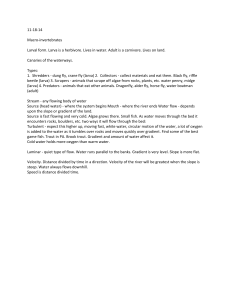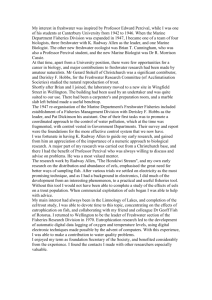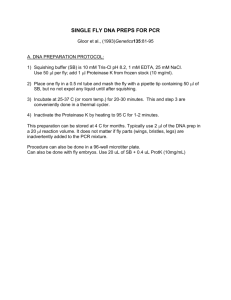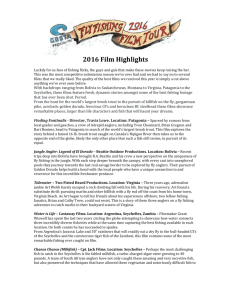2. Riverflies - Riverfly Partnership
advertisement
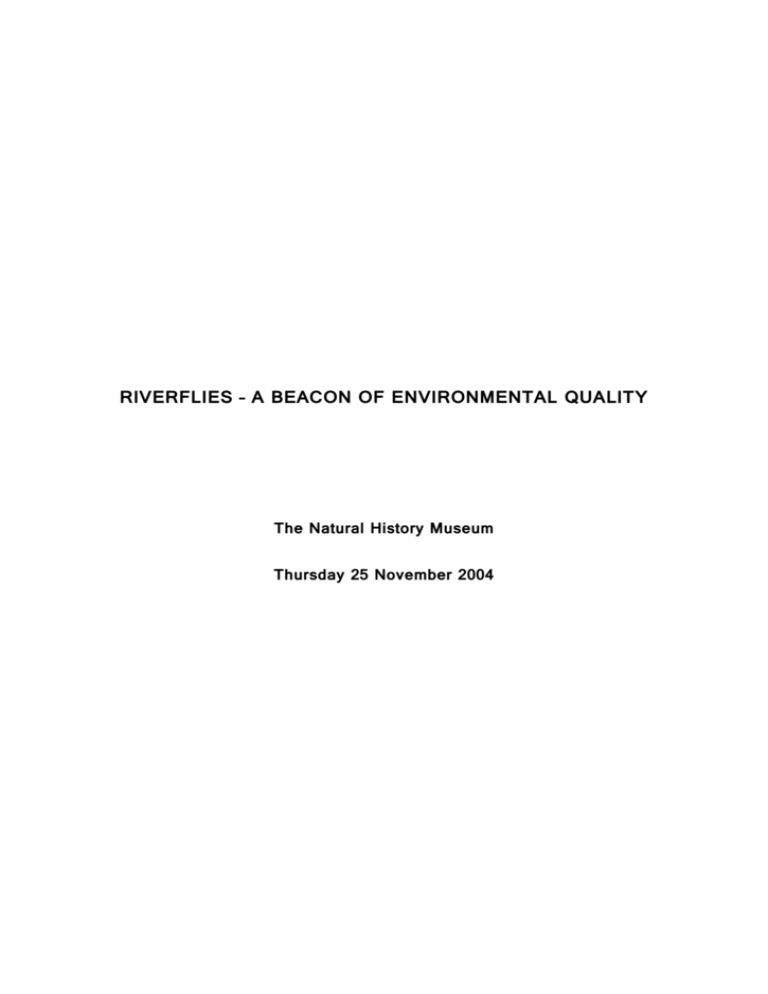
RIVERFLIES – A BEACON OF ENVIRONMENTAL QUALITY The Natural History Museum Thursday 25 November 2004 Organised by the Riverfly Interest Group Kindly supported by the Natural History Museum, English Nature, Environment Agency, Buglife – The Invertebrate Conservation Trust and The Salmon and Trout Association RIVERFLIES1- A BEACON FOR ENVIRONMENTAL QUALITY 09.30-10.00 Registration & refreshments Foyer, Flett Theatre LECTURE PROGRAMME Flett Theatre 10.00 Welcome Richard Lane, Director of Science, The Natural History Museum 10.05 Introduction Matt Shardlow, Buglife and Chair of the Riverfly Interest Group RIVER MANAGEMENT IN RELATION TO RIVERFLIES 10.15 Chair Matt Shardlow Managing for the fly fishing experience Paul Knight, Salmon and Trout Association 10.35 Riverflies in the Environment Agency remit Ian Johnson, Environment Agency 10.55 River invertebrate conservation Jon Webb, English Nature RIVERFLY TRENDS & AREAS OF CONCERN Chair Peter Lapsley 11.20 Climatic effects on upland riverflies Steve Ormerod, University of Wales, Cardiff 11.45 Environment Agency – findings and approaches Graham Lightfoot/Shirley Medgett, Environment Agency 12.10 The future – what the fisherman can do Cyril Bennett, John Spedan Lewis Trust for the Advancement of the Natural Sciences 12.35 – 13.45 Lunch OVERVIEW & PANEL DISCUSSION Chair: Ian Gibson MP, Science & Technology Select Committee 13.45 The National Riverfly Recording Schemes - CAMSTARS Craig Macadam, National Ephemeroptera Recording Scheme Co-ordinator 14.00 Overview of riverfly trends Steve Brooks, The Natural History Museum 1 Riverflies include Ephemeroptera (mayflies or up-winged flies), Trichoptera (caddisflies or sedges) and Plecoptera (stoneflies) a total of 279 British species. These groups represent the natural flies fly fishermen imitate with their artificial lures. 14.20 Panel discussion and questions from the audience Panel drawn from the morning speakers and chairs 15.45 Summing up & concluding remarks Matt Shardlow, Riverfly Interest Group 16.00 Close & refreshments Welcome Richard Lane PhD, Director of Science, The Natural History Museum As Director of Science, Richard Lane is responsible for earth and life sciences as well as the library and information services of the Natural History Museum, London. His function is to set the strategy for science, ensure that the research is relevant and maintained at a high quality and that the research collection of some 70 million items from all parts of the world operates as a major scientific infrastructure. There are approximately 350 staff (including research, curatorial and information staff) and 150 post-graduate students within this overall area of responsibility. _____________________________________________________________________I ntroduction, Chair & closing remarks Matt Shardlow MPhil, Buglife and Chair of the Riverfly Interest Group _____________________________________________________________________ Matt has been the Conservation Director of Buglife - The Invertebrate Conservation Trust since it’s initiation in 2002. Buglife is the only organisation in Europe committed to the conservation of all types of invertebrates. The charity now has six members of staff and a growing portfolio of conservation projects. Work areas include freshwater conservation policy, brownfield wildlife, Biodiversity Action Plans, a national bumblebee survey and conserving soft rock cliff biodiversity. Previously Matt was responsible for overseeing the management and monitoring of biodiversity on the RSPB’s 115,000ha of nature reserves. Contact details: Buglife - The Invertebrate Conservation Trust, 170A Park Road, Peterborough, PE1 2UF. Telephone: 01733 201210, Email: matt.shardlow@buglife.org.uk Matt will set the scene for the day, addressing the questions: 1. Why are riverflies important? 2. What is the Riverfly Interest Group? 3. What will happen today? 4. What should we get out of today? The joint Riverfly Recording Scheme initiative, CAMSTARS, will be launched. RIVER MANAGEMENT IN RELATION TO RIVERFLIES Chair Matt Shardlow _____________________________________________________________________ Managing for the fly fishing experience Paul Knight, Executive Director, Salmon and Trout Association _____________________________________________________________________ Paul entered trout farming in 1976, and qualified with Institute of Fisheries Management Diploma in 1981. Established lake and river trout sport fishery in Wiltshire in 1984, and served as Chairman of the Association of Stillwater Game Fishery Managers from 19992002. Appointed Deputy Director of Salmon & Trout Association in 1994 and Executive Director in January 2002. The Association, which represents the interests of 100,000 game anglers and fishery managers throughout the UK, seeks to influence water quality and fly life issues by lobbying Government departments and agencies, supported by practical experience and sound scientific evidence. Email: hq@salmon-trout.org Fly life is a natural barometer to the quality of the aquatic environment in both lakes and rivers, and this is the resource upon which the sport of angling depends. This paper will look at the important flies for anglers, both in their nymph and adult stages, and briefly describe their importance in the food chains of aquatic ecosystems. Water quality and habitat are central to healthy invertebrate populations, and the main requirements, and threats, are discussed. Managing for the fly fishing experience is required on several levels. Fisheries management maintains and improves local habitat, while water provision and sewage treatment operations by water companies directly impact water quality, all of which is regulated by the Environment Agency. On a wider national level, delivery of state and European legislation affecting the aquatic environment, whether directly or via, for instance, agricultural programmes, is the responsibility of the Department for the Environment, Farming and Rural Affairs (Defra). NGOs, such as the Salmon & Trout Association, seek to influence Government policy by lobbying Defra departments and agencies over relevant issues, and sit on Stakeholder Groups representing angling and fisheries interests. A healthy fly life will support high quality fisheries, attracting anglers and so benefiting local community economies, which, in turn, provide more investment to maintain and improve the aquatic environment. _____________________________________________________________________ Riverflies in the Environment Agency remit Ian Johnson, National Fisheries Policy Manager, Environment Agency _____________________________________________________________________ Ian is the Environment Agency’s lead Manager for River Flylife issues, with a 20-year background in aquatic ecology and fisheries. National Fisheries Policy Manager for habitat, environmental quality and land-use impacts on fisheries for England and Wales. Email: ian.johnson@environment-agency.gov.uk The Environment Agency has a general duty to conserve flora and fauna through the work it undertakes and this therefore includes the river flies. This paper aims to give an overview of this remit and our future approach. We have a long history of using invertebrates in the monitoring of river water quality, with the presence or absence of particular insect species being used to indicate and sometimes diagnose environmental problems. Insects are particularly good indicators of biological oxygen demand, acidification and unsurprisingly, pollution by insecticides. They may also indicate other important environmental stresses that would be of concern to the Environment Agency, such as flow or the impacts of climate change. In addition to our conservation duty we have a responsibility to maintain, improve and develop fisheries. Thus, the character and scale of the river fly hatches so important to flyfishing, and in turn the fly-fishing industry, are of prime interest to us. As a consequence the Environment Agency’s National Trout and Grayling Strategy includes specific targets to establish within our water quality monitoring, some assessment of the key angling fly species and to ensure their adequate protection where possible. Also of significant importance is the Water Framework Directive, which aims to bring all river water bodies to “good ecological status” by 2015. Rivers meeting this status will have the “composition and abundance of benthic invertebrate fauna” expected for a river of that type. The Environment Agency therefore has a duty to draw up River Basin Plans to deliver, amongst other things, insect communities of good ecological status and has committed itself to this aim. _____________________________________________________________________ River invertebrate conservation Jon Webb, English Nature _____________________________________________________________________ Jon Webb is an Invertebrate Ecologist with English Nature specialising in wetland insects. Previously, Jon has worked for a Wildlife Trust, a museum and within the planning department of a Local Authority. Contact details: Jon Webb, Terrestrial Wildlife Team, English Nature, Northminster House, Peterborough, PE1 1UA Introducing the vast diversity of freshwater habitats in the UK, Jon will explore the main niches along the river and the wealth of freshwater invertebrates these habitats host. He will explain how riverflies (mayflies, caddisflies and stoneflies) are just part of the interest which can be found in watercourses, which also include ground beetles (wreckers and pirates), stiletto-flies (deadly assassins) and many more. Jon will outline the key processes and mechanisms employed to protect and conserve UK habitats and species and the problems they face. RIVERFLY TRENDS & AREAS OF CONCERN Chair Peter Lapsley Peter Lapsley has been fishing for trout, sea trout and grayling in the UK and overseas for over 45 years.. He is a member of the Game Angling Instructors Association (GAIA) and holds the Salmon & Trout Association National Instructor’s Certificate (STANIC) and the Advanced Professional Game Angling Instructor’s (APGAI) ‘Trout & Sea Trout’ and ‘Fly Tying’ certificates. Peter has written, co-written or edited nine books on fly fishing including, Fly Fishing by J. R. Hartley, and J. R. Hartley Casts Again. Guide, was published in September 2003. His latest book, River Flyfishing: the Complete He has contributed countless articles to British and overseas game angling and field sports magazines, including The Shooting Times, Salmon, Trout & Sea Trout and has contributed to every issue of Fly Fishing & Fly Tying since it was first published in 1992. In his writings Peter has demonstrated a strong commitment to the view that anglers and conservationists can and should work together for the good of Britain’s lakes, streams and rivers - the arteries and veins of the natural environment. _____________________________________________________________________ Climatic effects on upland riverflies Professor Steve Ormerod, University of Wales, Cardiff _____________________________________________________________________ Steve Ormerod is professor of ecology in Cardiff School of Biosciences and widely known as an advisor to many government bodies and NGOs. He has published around 200 papers on the ecology of aquatic ecosystems. Email: Ormerod@Cardiff.ac.uk Riverfly communities have been assessed annually at the Llyn Brianne experimental catchments since the early 1980s. Initially established to assess the effects of catchment land use and acid rain on sensitive streams, long-term trends at these sites have since revealed that: i) there has been no detectable biological recovery from acidification, and acid episodes still have major biological effects; ii) there have been major fluctuations in riverfly community composition and abundance that track long-term climatic fluctuations – specifically the warmer, wetter phases of the North Atlantic Oscillation (NAO). In comparison with recent summer droughts (1990, 95, 96), the NAO in winter appears to affect stream riverflies over prolonged periods (years). I argue for a better understanding of these effects since they not only indicate the ecological conditions likely in future climates, but also may reflect a recent intensification of the NAO due to climate forcing. _____________________________________________________________________ Environment Agency – findings and approaches Graham Lightfoot and Shirley Medgett, Environment Agency _____________________________________________________________________ Dr Graham Lightfoot is a Technical Specialist in the Fisheries function and was previously Fisheries, Ecology and Recreation Manager for South Wessex Area of South West Region of the Environment Agency. Shirley Medgett has 20 years experience as a freshwater ecologist and has worked on the Rivers Test and Itchen since 1989. She is currently Ecological Appraisal Team Leader in Hampshire and Isle of the Wight Area of Southern Region of the Environment Agency. Emails: graham.lightfoot@environment-agency.gov.uk shirley.medgett@environment-agency.gov.uk The presentation deals with the origins of the fly abundance issue, the Millennium Chalk streams Fly Trends Study, and the approach taken in these two Areas of the Environment Agency to improve understanding of the key processes underlying fly abundance changes of concern to anglers. Findings from the R. Avon and the R. Itchen are presented, and possible underlying mechanisms involving both climatic and anthropogenic influences discussed. Information is also presented in relation to factors involved in fly abundance issues in other parts of England and Wales. _____________________________________________________________________ Anglers protecting their rivers Cyril Bennett, John Spedan Lewis Trust for the Advancement of the Natural Sciences _____________________________________________________________________ Dr Cyril Bennett is a freshwater entomologist whose main research area is the taxonomy of freshwater insects and the use of these as indicators of pollution. Cyril’s PhD with the University of London was on ‘The Ecology of Mayflies in the Upper reaches of the River Wey in Surrey’. Cyril has since been involved in identifying a number of pollution incidents on the River Wey. He is a member of the scientific panel of the Test and Itchen Association and works with a team at The John Spedan Lewis Trust for the Advancement of the Natural Sciences at Leckford carrying out research on mayflies & caddisflies. Cyril tutors on both the Riverfly Workshops, run locally by the John Spedan Lewis Trust for the Advancement of the Natural Sciences and nationally by The Natural History Museum / English Nature partnership. Cyril has been a keen fly fisherman for nearly 50 years where his interest in freshwater entomology first developed. His early career as a commercial photographer led to a keen interest in natural history photography. Whilst the methods used by the Environment Agency for assessing the water quality of our rivers shows that 95% are of good to fair quality, this does not reflect growing concerns about the declining fly populations in many of our rivers. This is because the invertebrate monitoring procedure does not include abundance levels and there are also considerable gaps during which serious pollution incidents could go undetected. Environment Agency data, recorded on the River Wey, are used to highlight these problems and whilst an increase in the frequency of monitoring is probably prohibitive due to costs, the inclusion of invertebrate abundance levels into water quality assessments is not. Anglers are ideally placed to work in partnership with the Environment Agency to carry out basic invertebrate monitoring to give an early warning of pollution incidents and this partnership is working well on the River Wey where invertebrate abundance levels are now beginning to return to normal. Anglers, and particularly river keepers, can also use well established methods to improve their fly populations and the reintroduction of the Mayfly (Ephemera danica) to the River Wey is used as an example. The Riverfly Workshops, run locally by the John Spedan Lewis Trust for the Advancement of the Natural Sciences and nationally by The Natural History Museum, aim to give anglers and river keepers the skills necessary to carry out basic invertebrate monitoring together with more detailed tuition in the identification of riverflies in order to feed information into the National Recording Schemes. _____________________________________________________________________ Recording Riverflies: The work of the National Riverfly Recording Schemes Craig Macadam – CAMSTARS, National Ephemeroptera Recording Scheme Officer _____________________________________________________________________ Craig Macadam worked in the Scottish water industry for 12 years, and now runs Bradan Aquasurveys Ltd., an environmental consultancy specialising in freshwater ecology, with his wife Carolann. Craig is the National Co-ordinator of the Ephemeroptera Recording Scheme and is particularly interested in changes in the flight periods of mayflies and the potential for new mayfly species being present in Britain. Craig is currently developing simplified keys and methods for identifying both larval and adult Ephemeroptera and is collaborating with European Ephemeropterists to develop a pan-European key to Ephemeroptera larvae. Contact details overleaf Ephemeroptera (mayflies), Plecoptera (stoneflies) and Trichoptera (caddisflies) form a natural group being found together as both young and adults. In addition, as a group of larger aquatic flies they feature prominently in the life of anglers. CAMSTARS, the recording schemes for Ephemeroptera, Plecoptera and Trichoptera, is run by Craig, David and Ian, and plays a crucial role in conserving riverfly populations by encouraging amateur naturalists to pursue an interest in, study and monitor their riverflies. The schemes are run on a voluntary basis under the umbrella organisation of the Biological Records Centre (funded by DEFRA) with the key objectives being to: 1 Be the definitive source of information on the distribution of Ephemeroptera, Plecoptera and Trichoptera species in England, Scotland and Wales (linking with Irish coworkers); 2 Encourage interest in these species and their associated habitats; 3 Target research on rare species and under recorded habitats; 4 Provide guidance on identification, particularly with “difficult” species; 5 Feed information to the statutory bodies which drive National conservation strategies 6 Make the records widely available via the National Biodiversity Network’s “Gateway”. Anglers are in an ideal position to study riverflies both to monitor the quality of the water body and also contribute species records to the National Recording Schemes. Records from individuals and groups are particularly valuable to the schemes as they are often from habitats such as small streams, marshes, pools, Environment Agency remit or resources to survey. trickles, etc. that are outwith the In addition, amateur recorders can sample all through the year and are often very familiar with their local river. The Environment Agency remit and associated resources means that the statutory bodies can only sample a few sites on each river at most twice a year. In an initiative to help interested individuals take forward their interest in monitoring and recording riverflies, and in doing so help take action to conserve the river environment, the three Recording Scheme Co-ordinators collaborate with specialists from the Natural History Museum and the John Spedan Lewis Trust for the Advancement of Natural Sciences to deliver Riverfly Workshops for fly fishermen. These one day workshops introduce monitoring and identification techniques for both larvae and adult specimens. The Recording Scheme Co-ordinators are present at the conference and welcome your interest and involvement in the schemes. Please do register your interest with them or contact the scheme organisers, as below: For further information see www.brc.ac.uk/schemes/CAMSTARS/homepage.htm Craig Macadam: National Ephemeroptera Recording Scheme Website: www.ephemeroptera.org.uk, Email: info@ephemeroptera.org.uk David Pryce: National Plecoptera Recording Scheme Email: david.pryce@environment-agency.gov.uk Dr Ian Wallace: National Trichoptera Recording Scheme Email: ian.wallace@liverpoolmuseums.org.uk _____________________________________________________________________ Overview of riverfly trends Steve Brooks, The Natural History Museum _____________________________________________________________________ Steve Brooks is a Research Entomologist at The Natural History Museum, London, studying the ecology, systematics and taxonomy of freshwater insects. His current research is focused on the use of freshwater insects as indicators of environmental change, in particular the analysis of chironomid midges and the development of models to reconstruct past changes in climate and nutrients, and the impacts of acidification and heavy metal pollution. Steve has published four books, including popular works on dragonflies, and about 80 peerreviewed scientific papers and book chapters. He is an Honorary Reader in the Department of Geography, University College London. Email: S.Brooks@nhm.ac.uk In this paper Steve reviews the long term trends in freshwater insects that are available from several sources including records from fishermen, the Acid Waters Monitoring Network and the Environmental Change Network and will consider what might be driving these changes. There are compelling indications that natural climatic cycles may be influencing riverfly populations, and these climatic cycles may be modified by climate change in the future. Climate change may lead to changes in phenology and distribution of riverflies. At a local level, climate can influence river catchments in different ways. Changes in precipitation leading to reduced flows can concentrate pollutants and increase deposition of silt. Reduced precipitation may also result in increased water abstraction and forecast climate change suggests that we may expect demands for abstraction to increase, especially in the south. On the other hand, increased precipitation may lead to pollution incidents from increased run-off. Changes in sulphur and nitrogen deposition influence pH and may lead to nutrient enrichment. Spillage of sheep dip and other biocides can devastate insect populations for miles downstream while the impact of oestrogens on insects is poorly understood.

